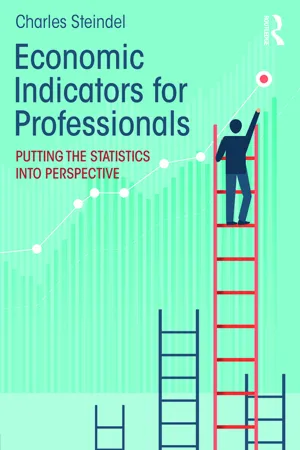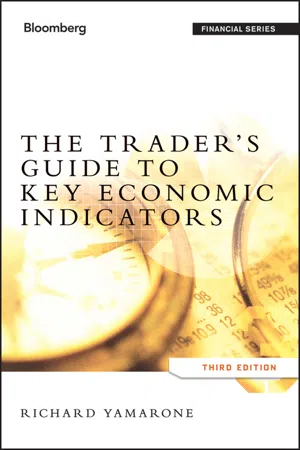Economics
Measured GDP
Measured GDP refers to the total market value of all final goods and services produced within a country's borders in a specific time period. It is a key indicator of a country's economic health and is used to assess the size and growth of the economy. Measured GDP is often used to compare the economic performance of different countries.
Written by Perlego with AI-assistance
Related key terms
Related key terms
1 of 4
Related key terms
1 of 3
12 Key excerpts on "Measured GDP"
- eBook - ePub
Introducing a New Economics
Pluralist, Sustainable and Progressive
- Jack Reardon, Maria Alejandra Caporale Madi, Molly Scott Cato(Authors)
- 2017(Publication Date)
- Pluto Press(Publisher)
Gross Domestic Product (GDP) , defined as the market value of all final goods and services produced within a nation’s geographical borders in one year. GDP measures the market value of economic activity, or, in other words, the amount of stuff that an economy produces in one year. This is a rather strange measure to set at the heart of policy-making, since it excludes many things we value that are never bought and sold (most importantly the environment). The end result is quantitative – a single number reported in the nation’s currency – rather than qualitative.Key points about GDP
• The final goods and services considered in GDP are produced within the country, that is, within the country’s geographical borders, irrespective of the nationality of the producer or of the firms’ capital composition.• Transactions in the informal economy, and goods and services produced by households for their own consumption, are excluded from GDP. So if I do all my housework, this work is not included in GDP, but if I contract these services out, it is.• Only human-made capital (such as factories, computers, etc. is included in GDP. Environmental, human (intellectual) and social capital are excluded.• Thus, depreciation (the normal wear and tear of a good over time) of only human-made capital is included in the calculation of GDP. Depreciation increases with the use of capital goods in the production of goods and services, and can also be influenced by technological innovation.• Price changes can affect the monetary value of final goods and services produced and exchanged by a country in a specific period of time, without changes in the volume of such goods and services. Thus, it is essential to distinguish between ‘nominal GDP’ and ‘real GDP’, so as to exclude from the latter the effect of price variations. Nominal GDP uses current prices whereas real GDP - No longer available |Learn more
Contemporary Economics
An Applications Approach
- Robert Carbaugh(Author)
- 2016(Publication Date)
- Routledge(Publisher)
Adding the market value of all goods and services gives the total market value, or GDP. The reason we multiply the quantity of goods by their respective prices is that we cannot simply add the number of apples and the number of oranges. Using prices permits us to express everything in a common standard of value, in this case dollars.Of All Final Goods and Services
GDP is a comprehensive measure of a nation’s output. It measures the market value of not only apples and oranges but also many other goods, such as jetliners, calculators, and clothing. GDP also accounts for intangible services such as banking, engineering, medical, and legal services. When you purchase a video of your favorite rock concert, you are purchasing a good, and the purchase is part of GDP. When you go to a football game, you are buying a service, and the ticket price is also part of GDP.Note that only “final” goods and services are included in GDP. Many goods and services are purchased for use as inputs in the production of other goods. For example, McDonald’s buys ground beef to make Big Macs. If we counted the value of the ground beef and the value of the Big Mac, we would be counting the ground beef twice, thereby overstating the value of the production. Final goods therefore are finished goods and services that are produced for the end consumer.Produced
GDP measures the current production of an economy. Many financial transactions take place, but they do not directly generate current output, and so they must be excluded from GDP. These transactions include transfer payments such as welfare payments and Social Security payments that the government makes to individuals. They also include a college student’s yearly subsidy from his family to finance his college education. Moreover, purchases and sales of stocks and bonds are not part of GDP because they do not represent the production of new goods and services.Within a Country
GDP includes the value of production within the boundaries of a country. When a Mexican citizen works temporarily in the United States, her production is part of U.S. GDP. When General Motors owns an assembly plant in Canada, the autos produced at that plant are part of Canada’s GDP rather than U.S. GDP. - eBook - ePub
Getting the Measure of Money
A Critical Assessment of UK Monetary Indicators
- Anthony J. Evans(Author)
- 2018(Publication Date)
- London Publishing Partnership(Publisher)
111Figure 20 Multi-factor productivity, 1997–2014There are three alternative approaches: output, income and expenditure. One of the main differences between them is the speed of data compilation, since the output approach provides the first estimate. Crucially, it is based on the concept of ‘value added’, which focuses on the difference between gross output and intermediate consumption at each stage of production.112 The income approach (or GDI) measures the sum of income generated by various groups of producers (for example, corporations, employees, the self-employed). The expenditure approach measures the amount of money spent across all sectors of the economy (i.e. consumption, investment, government spending and net exports). National income accounting is a relatively new phenomenon and its emergence coincided with the command economy of wartime, because ‘planning for the war effort required information on production and spending by type of product and purchaser’ (Landefield et al. 2008: 195).Perhaps the biggest problem with national income accounting is the difficulty in finding a common unit to provide a basis for measurement. Using the cash value of an exchange glosses over the fact that (i) people only exchange when the marginal value is greater than the marginal cost, therefore the exchange price only provides a lower bound of value creation, not an estimate; and (ii) focusing on the monetary value is only a notional measure. The sole reason for engaging in indirect exchange (i.e. using money) is to buy goods and services in the future. Thus, money is merely a ‘loose joint’ that fails to provide a common unit to compare, for example, apples and pears. The classic critique stems from the originator of national income accounting, with Simon Kuznets famously stating that ‘the welfare of a nation [can] scarcely be inferred from a measure of national income’ (Kuznets 1934: 7). But we can split these limitations into two separate critiques. - eBook - ePub
A Primer on Macroeconomics, Second Edition, Volume I
Elements and Principles
- Thomas M. Beveridge(Author)
- 2018(Publication Date)
- Business Expert Press(Publisher)
Every day, the government publishes a great many economic statistics. Most of these are highly technical and of interest only to professional economists and other financial analysts and to policy makers. A few numbers, however, are widely reported, closely analyzed, and hotly debated by pundits in the media. The unemployment rate and the inflation rate, for example, may be of profound political significance, and unexpected or unwelcome changes in these values can trigger substantial changes in the stock market, which may affect our 401ks or other financial assets. The economic growth rate is chief among these highly significant numbers published by the government. To determine how rapidly economic production is growing, the government must first determine the level of economic production. It does this through national income accounting—the topic of our current chapter.National Income Accounting: Gross Domestic Product Definition of Gross Domestic Product and Exclusions from the DefinitionOur current framework of national income accounting began in the 1930s when the need was pressing to monitor the effectiveness of New Deal policy actions. The primary measure of total production used nowadays is GDP. GDP is defined as the total market value of all final goods and services produced within an economy’s boundaries in a given period of time.Note the definition’s emphasis on production. This year’s GDP measures the value of what is produced this year, not how much is bought and sold this year. For this reason, we are not interested in resold goods or second-hand sales. Our focus isproduction —these goods have only been produced once and, therefore, must only be counted once.THINK IT THROUGH : There are complications. The services of a recycling firm should be counted as part of this year’s GDP—the services provided are new and, therefore, require inclusion. Similarly, restoration services on a 1955 Cadillac that is then sold on eBay must be included—a productive service has been rendered.Note, too, the word “ final ” in our definition. Many goods and services are classified as - eBook - ePub
- David G. Tuerck(Author)
- 2021(Publication Date)
- Business Expert Press(Publisher)
CHAPTER 2 Macro Measures There are numerous ways to assess the performance of the macroeconomy. On the first Friday of each month, the U.S. Bureau of Labor Statistics provides estimates of what might be the most commonly cited measures of macroeconomic performance—the number of jobs created or lost and the unemployment rate for the preceding month. The attention given to these numbers reflects the Keynesian-inspired preoccupation with jobs or, more precisely, with the failure of the private sector to “create” enough jobs to eliminate the excess supply of labor brought about by a lack of aggregate demand. 1 As fascinated as politicians and the public might be with the employment numbers, there is a more comprehensive measure issued every calendar quarter, namely, the growth of real, inflation-adjusted gross domestic product (GDP) during the preceding quarter. It is this indicator that economists most often refer to in assessing macroeconomic performance. GDP is the market value of final goods and services produced within a country over a year’s time. Even though it is the most commonly used measure of macroeconomic performance across the globe, GDP has come in for criticism in recent years as a macroeconomic indicator. In his book, Gross National Happiness, Arthur C. Brooks claims that it is “happiness” that matters and that happiness has little to do with GDP but depends more on the nation’s commitment to spiritual and family values. The astronomical rises in American GDP reflect the fact that, as a nation, we are creating huge amounts of value—we are the most successful nation on earth. Yet… happiness doesn’t follow GDP growth over time. In the United States, our gross national happiness has remained essentially static for the past three decades (Brooks 2008, pp - eBook - ePub
- Dan Richards, Manzur Rashid, Peter Antonioni(Authors)
- 2016(Publication Date)
- For Dummies(Publisher)
Part 2 Measuring the Things That Matter IN THIS PART … Get a firm grip on Gross Domestic Product (GDP) and everything that goes into calculating it. Discover what inflation is, why it may explode into hyperinflation, and why a little inflation may be a good thing. Understand how interest rates are a different kind of price and their role in savings and investment. See how unemployment affects an economy, understand how it’s measured, and find out what causes unemployment levels to change. Chapter 4 Adding Up Gross Domestic Product IN THIS CHAPTER Understanding the measurement of GDP Discovering the components of GDP Seeing how GDP is related to living standards Thinking about inequality Macroeconomists love talking about gross domestic product (GDP) as much as sci-fi fans love discussing Star Trek, TV chefs the benefits of organic turnips, and Donald Trump the size of his hands. When economists examine a country’s economy, GDP is probably the first thing they look at — and for good reason. It provides a convenient snapshot of the total amount of economic activity taking place in a country. More precisely, it reveals the value of everything an economy produces in one year. The total production idea is key. If the economy produced just one good, say oil or sugar, total production would be easy to measure. It might be 3 billion barrels of oil per year, or 40 million metric tons of sugar. Of course, a vast economy the size of the U.S. produces thousands of different goods, not just one. So, how can we measure this total? The answer is “we pretend.” Or, in macroeconomics jargon, we assume. In particular, we pretend that the economy does produce just one good. It’s not oil or sugar per se — it’s simply called GDP. The thing about this pretend GDP good that is really special is that it has an incredible range of uses. You can take a chunk of GDP and mold it into transportation services, or into manufactured goods, or health services, or food, or shelter, or clothing - eBook - ePub
Economic Indicators for Professionals
Putting the Statistics into Perspective
- Charles Steindel(Author)
- 2018(Publication Date)
- Routledge(Publisher)
A sophisticated reader may note that, unlike the situation in Petty’s day, in modern nations the income earned from a significant degree of a nation’s production may accrue to foreign owners, while domestic residents may earn income from activities located in foreign nations. GDP is a measure of income-producing economic activity within the borders of the United States. The workers and businesses who produce GDP include foreigners working in the US and foreign-owned businesses in the US, while income earned overseas by Americans is not counted in GDP. Gross National Product (GNP), the older concept headlined before the 1990s, is an aggregate measure of economic activity that produces income for American individuals and businesses, no matter where on the globe that activity occurs. Income earned by foreigners from production in the US is excluded from GNP.Also, as a matter of technical economics, the equality of sales and income is not an example of Say’s Law. The latter is the proposition that the quantity of items produced always matches the quantity of products demanded. A major point of difference between Keynesian and non-Keynesian economists is that the former believe that Say’s Law need not always hold in a monetary economy.12 All the services mentioned are used, and purchased, by retailers whether or not the actual item in the store was made by a domestic manufacturer. The reality is that sales of imported items will contribute to US GDP through the need to use domestically produced intermediate services to supply them to US customers (Steindel, 2004).13 As noted, Petty’s original estimates were based on rudimentary information on incomes, and he was not especially concerned with changes in the aggregates from one year to another. Snapshots of the size and structure of an economy certainly have their uses, but in the modern US the greater interest is often in the near-term evolution of the economy, putting the focus on changes, or growth rates, of economic statistics.14 Input-output tables contain estimates of the purchases sectors make from other sectors to produce the goods and services they sell. These figures allow BEA to estimate, for example, how much wheat was purchased from farmers this period to bake today’s bread. Input-output tables are derived from detailed data on business spending and sales collected in economic censuses. The economic censuses are conducted at five-year intervals. BEA infers how the relationships across sectors evolve between those benchmark years, and have changed since the last census year, in order to make the needed corrections to aggregate measures of sales, which are available annually and quarterly. BEA’s input-output tables can be found at https://bea.gov/iTable/index_industry_io.cfm - eBook - ePub
- Neil Harris(Author)
- 2007(Publication Date)
- Routledge(Publisher)
When examining microeconomics we saw that, if demand equalled supply, this determined the equilibrium price and quantity. Similarly, we can examine the economy and calculate the quantity of output of goods and services supplied by all businesses, however defined. This is called national product. However, in the economy as a whole, there is no guarantee that aggregate demand will automatically equal aggregate supply; we return to this later. In the meantime, there are several definitions of national product to consider.Gross Domestic Product (GDP) at Factor CostThis measures the total value of output produced in a country during a period of time, usually one year. It doesn’t matter if the businesses are British or foreign owned, so long as the goods and services are produced in the UK.Gross Domestic Product (GDP) at Market PricesWhen goods are produced and sold they are taxed, by value added tax (VAT) or by excise duties for alcohol, petrol and tobacco. These are indirect taxes since they are levied on the consumer indirectly, as opposed to direct taxes, like income tax and capital gains tax. Businesses also receive subsidies to encourage them to produce particular products; British Aerospace, for example, to encourage them to contribute to the Airbus consortium, or Ford and Rover cars to help maintain jobs. As we saw in Chapter 8 , these determine the market prices at which the products are sold. We must allow for these indirect taxes and subsidies when calculating the GDP of a country, or we will get false values. Therefore:GDP at market prices – taxes on expenditure (e.g. VAT and excise duties)+ subsidies= GDP at factor costGross National Product (GNP)GNP is the value of output produced by a country regardless of where in the world the services from its factors of production are supplied. Therefore, money invested overseas in the shares of foreign companies will generate income for the UK as dividends. Other overseas income include royalties from the sales of compact discs and videos by British pop stars, UK developed computer games and profits from overseas investments such as constructing an oil refinery in Nigeria. All revenues generated in these and many other ways, which may be in the form of interest on loans or rents, need to be taken into account, since this money, called property income, will return to the UK. Conversely, property income will leave the UK as payment to foreign investors who provide similar services to the UK, e.g. Nissan’s profits repatriated to Japan. The difference between the in-flows of income and the out-flows is net property income from abroad. GNP can also be measured at market prices or factor cost. - eBook - ePub
- Jinzao Li(Author)
- 2017(Publication Date)
- WSPC(Publisher)
As the most comprehensive economic indicator, GDP is connected to a number of economic and even non-economic indicators. Judging from the formation of GDP as the most comprehensive indicator, the indicators with the closest relationships to GDP are: net domestic product (NDP), gross national income (GNI) and gross disposable income (GDI). Furthermore, GDP is also closely connected to such indicators as price, inflation rate, fiscal revenue and credit.i.GDP, NDP, GNI and GDI
GDP refers to the final products at market prices produced by all resident units in a country (or a region) during a certain period of time calculated at market price. Gross domestic product has three forms, namely, value, income and products. GDP in its value form refers to the difference between the total value of all goods and services produced by all resident units during a certain period of time and the total input value of goods and services of non-fixed assets within the same period of time; in other words, it is the sum of the value-added of all resident units. GDP from the perspective of income includes the primary income generated by all resident units within a fixed period of time and distributed to resident and non-resident units. GDP from the perspective of products refers to the value of end-use goods and services by all resident units minus the value of imports of goods and services during a given period of time.16Net domestic product (NDP) is the net value of all the final products and labour services produced by a country during a given period of time calculated at market rates. The calculation formula is: NDP = GDP – DepreciationGross national income or GNI, also known as gross national product (GNP), refers to the final result of the primary distribution of the income created by all resident units of a country (or a region) during a certain period of time. The value-added created by resident units of a country engaged in production activities is distributed, during the primary distribution, mainly to resident units of that country, while part of it is distributed to non-resident units in the form of production tax and import duties (minus subsidies to production and import), compensation for workers and property income. In the meantime, a part of the value-added created abroad is distributed to resident units of the country in the form of production tax and import duties (minus subsidies to production and import), compensation for workers and property income. The concept of GNI is thus developed, which equals GDP plus the net factor income from abroad. Unlike GDP, which is based on a concept of production, GNP is based on a concept of income.17 - eBook - ePub
- P Mohr, D Yu, S Adendorff(Authors)
- 2020(Publication Date)
- Van Schaik Publishers(Publisher)
The transformation of GDP at current prices to GDP at constant prices is a complicated process. Nominal GDP is broken down into its different components and each of these is then converted to values measured at the prices ruling in the base period. The values of the different components at constant prices are then added together to obtain real GDP. Details of these processes fall beyond the scope of this book. However, the difference between valuation at current prices and valuation at constant prices (ie between nominal and real values) is crucially important when national accounting data are analysed or interpreted.TABLE 2-3 Nominal and real GDP and nominal and real growth rates, 2010 to 2018Year GDP at current market prices (nominal GDP) GDP at constant 2010 prices (real GDP) Growth rates (% change since previous year) (R millions) (R millions) Nominal Real 2010 2 748 008 2 748 008 – – 2011 3 023 659 2 838 258 10,0 3,3 2012 3 253 851 2 901 076 7,6 2,2 2013 3 539 977 2 973 176 8,8 2,5 2014 3 805 350 3 028 090 7,5 1,8 2015 4 049 884 3 064 237 6,4 1,2 2016 4 359 061 3 076 465 7,6 0,4 2017 4 653 579 3 119 984 6,8 1,4 2018 4 873 899 3 144 539 4,7 0,8 Source: SARB Quarterly Bulletin, March 2019.2.7 SOME PROBLEMS ASSOCIATED WITH GDP
Although GDP is the best available measure of aggregate activity in the domestic economy, it is not a perfect measure. As a result, GDP is sometimes jokingly referred to as the “grossly deceptive product” or the “grossly distorted picture”. Users of national accounting data should always remember that the estimation of total production, income and expenditure in the economy is an enormous task. Various conceptual and measurement problems are encountered; it is often difficult to define precisely what should be measured, and the information is also often inadequate. As a result, the compilation of the national accounts involves liberal use 30 - eBook - ePub
- Richard Yamarone(Author)
- 2012(Publication Date)
- Bloomberg Press(Publisher)
statistical discrepancy , still remains—third quarter 2011 NNP, for instance, was $13.486 trillion and net national income was $13.435 trillion by the income-based calculation, a difference of $51.4 billion. This discrepancy reflects differences in the sources for data used in the two calculations. Those used in deriving national income are less directly observable, and so less reliable. As mentioned earlier, moreover, illicit expenditures are not reported or estimated.This section of the chapter has described the multitude of figures included in the GDP report, how they are related to one another, and how they are derived. Next come the nuts and bolts: how economists and traders use the report numbers in analyzing both big-picture issues, such as the future course of the business cycle, and smaller issues, such as when to put their money where.What Does It All Mean?
The GDP report contains a wealth of information about the nation’s economy. Each of its components tells a different story about a particular group, sector, industry, or activity. Not surprisingly, then, different market participants look at different sections and draw different inferences. Retail analysts, for instance, focus mostly on consumer spending. Those covering housing, construction, or real estate investment trusts (REITs) concentrate on the residential activity in investment spending. Defense-industry analysts focus on the national defense spending component of government consumption expenditures and gross investment. Fixed-income analysts and investors, ever wary of the eroding effects of inflation, concern themselves with the GDP deflators and GDP growth rate. Traders, who are always on the lookout for possible market movers, watch for numbers that contradict expectations, which they track carefully, often jotting them down in notebooks kept at their desks, for quick reference when the real figures are announced. - eBook - ePub
- Malcolm Sawyer, Jonathan Michie, Malcolm Sawyer, Jonathan Michie(Authors)
- 2022(Publication Date)
- Routledge(Publisher)
The findings of this paper have three macroeconomic policy implications. First, cheaper finance, healthcare, and PBS are better for economic growth. Governments can reduce the cost of these services on the net product and shift more resources to industries that directly contribute to the final product. Second, contra what the conventional measure of output indicates, the US economy has a deeper growth problem that precedes the Great Recession. As a result, industry-level pro-growth policies are suggested to generate more income while keeping an eye on resource and environmental constraints. Third, the finding of a lower and more rapidly declining labor share in the early 2000s signals growing distributional inequalities more strongly than indicated by the conventional labor share. In addition to policies that will increase the bargaining power of labor, it is more urgent to counter this trend by lowering the cost of finance, healthcare, and PBS on wage earners.The current national accounts were born during the Second World War, just after the Great Depression (Temin 2020 ). Governments initially wanted to measure how much of the output had melted down during the Depression (Stiglitz 2019a , 16). The idea behind official national accounts was to provide governments a reliable estimate to measure the effects of the Depression and government policies for recovery. With the rise of Keynesian economics, governments took an active role in shaping their economies and steering growth. In the absence of economic welfare indicators in the national accounts, maximizing GDP growth became the single policy objective, and policymakers started to care less about what we put in GDP as long as GDP continued to grow.However, how we measure GDP matters because it shapes how we perceive our economies and how we make policy decisions about them, as summarized in Figure 9 . The conventional measurement of financial, healthcare, and PBS output under the final product justifies excess-prices of these services because they bring a faster GDP growth. As these services expanded after 1980, policymakers tended to believe that they were becoming more productive and adding more value to our economies. This interpretation gave rise to incorrect incentives that encouraged rent-seeking activities such as predatory lending of banks, record drug prices, and expensive lawyer fees. According to Stiglitz (2012
Index pages curate the most relevant extracts from our library of academic textbooks. They’ve been created using an in-house natural language model (NLM), each adding context and meaning to key research topics.
Explore more topic indexes
Explore more topic indexes
1 of 6
Explore more topic indexes
1 of 4











